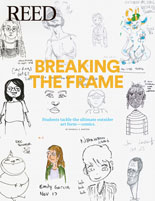
IRIS login | Reed College home Volume 96, No. 1: March 2017
Race, Class, and Reed
I am writing about the article “Protest Amplifies Discussion of Race on Campus” that appeared in the December 2016 issue. I was struck by a quote from Addison Bates ’18, one of 400 demonstrators demanding changes in the Reed curriculum and the hiring of more tenured black professors. Ms. Bates said: “Our goal is to move our institution away from perpetuating racism and towards perpetuating antiracism.” I think that this statement is mistaken because it is empty of any concrete content and rather irresponsible.
The article provides data of a higher dropout rate for black students than white students at Reed. Unfortunately, the partial statistics presented in the article ignore other sociological categories, such as wealth, or students that do not fit into the black and white mold.
Also absent in the article are the following words or phrases: poverty, inequality, contingent labor and part-time work as the new “normal,” poverty wages, the student loan crisis, Wall Street and capitalism. This is unfortunate because those terms could contribute an economic and class explanation of the plight of student, lower middle-class, and working-class youth in campuses and cities across the nation. A recent news item, for instance, reports on colleges setting up food banks for impoverished students. A survey of 3,000 college students published in October by Students Against Hunger indicates that an astounding 48% have faced food insecurity.
Earlier this month, economists Thomas Piketty, Emmanuel Saez, and Gabriel Zucman, leading experts on global inequality, released a groundbreaking study on the growth of income inequality in the United States between 1946 and 2016. The conclusions are staggering: Since the mid-1970s there has occurred one of the most rapid upward redistributions of income in modern history, for any country. The U.S. is now the most economically and socially unequal advanced nation in this entire planet.
The phenomenon of homeless students has also become more common; “One sees them discretely washing their teeth and themselves in the college restrooms in the morning,” one student told me during a Thanksgiving dinner for impoverished community college students given by a community church in California. Homelessness and the housing crisis go hand in hand; in Seattle, students are being asked to pay upwards of $700 a month for rooms the size of a parking lot stall. Median rents in Oakland, California, are now topping $3,000 a month.
Also left out of the equation are 25 years of imperialist wars, based on lies, being fought mostly by youth that have been forced by economic circumstances to join the military, “economic draftees.”
Surely all the above factors may help explain the low rates of graduation for black students at Reed and elsewhere.
According to another report, a layer of elderly citizens that retired on Social Security are having the student loans that they defaulted on deducted from their paltry Social Security checks, driving them below the poverty line.
I hope that this letter encourages Addison Bates and other students to see the issues that confront youth and college students in Portland and elsewhere in a larger, social context, because these are class issues. I think that those students that focus on race, which, I insist, represents a totally unscientific, totally abstract perspective, are making a mistake.
Ms. Bates has been quoted using the unfortunate phrase that Reed currently “perpetuates” racism. Those are very strong words that are not grounded in any evidence. I hope that Addison reconsiders and throws herself into a serious study, a serious campaign, really, of the economic causes and political solutions for the growing inequality, poverty, and police violence that more and more characterize our society.

LATEST COMMENTS
steve-jobs-1976 I knew Steve Jobs when he was on the second floor of Quincy. (Fall...
Utnapishtim - 2 weeks ago
Prof. Mason Drukman [political science 1964–70] This is gold, pure gold. God bless, Prof. Drukman.
puredog - 1 month ago
virginia-davis-1965 Such a good friend & compatriot in the day of Satyricon...
czarchasm - 4 months ago
John Peara Baba 1990 John died of a broken heart from losing his mom and then his...
kodachrome - 7 months ago
Carol Sawyer 1962 Who wrote this obit? I'm writing something about Carol Sawyer...
MsLaurie Pepper - 8 months ago
William W. Wissman MAT 1969 ...and THREE sisters. Sabra, the oldest, Mary, the middle, and...
riclf - 10 months ago